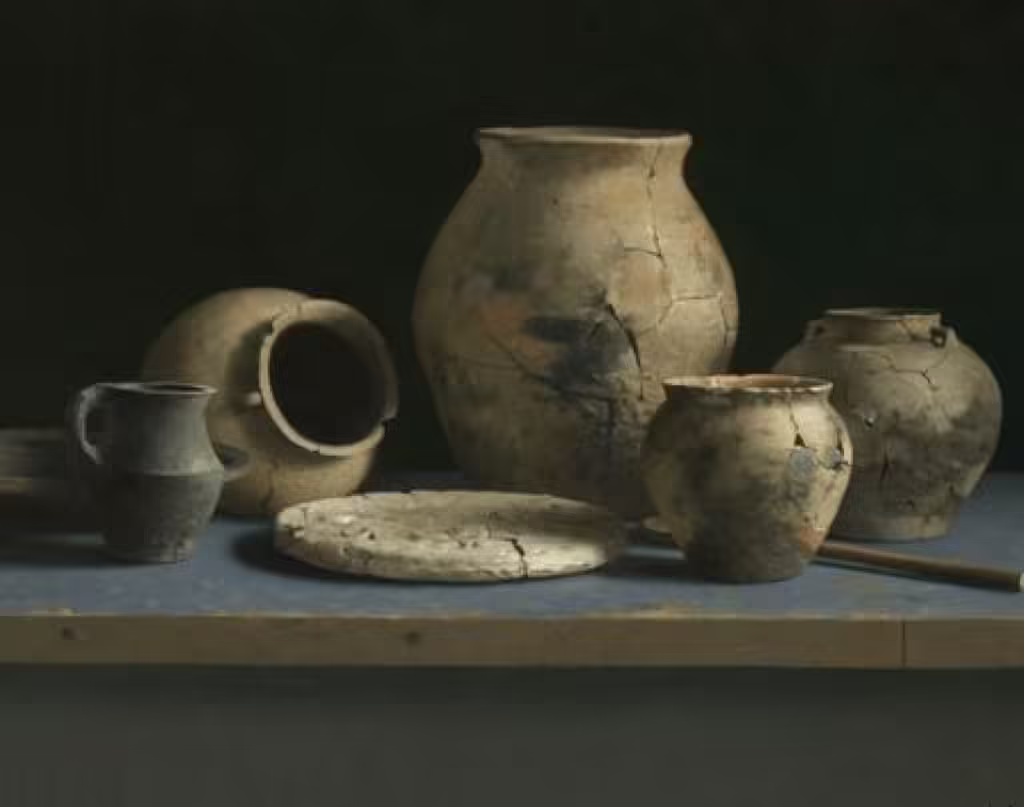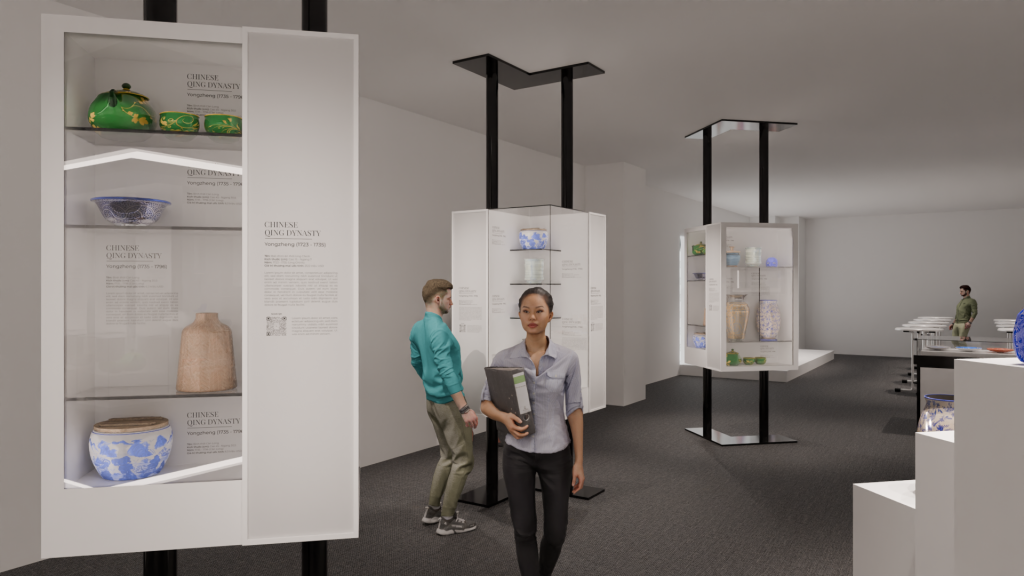Ancient ceramics – an epic of human creativity and perseverance, a timeless journey that depicts enduring cultural and artistic values. Katiart’s invites you to admire the masterpieces of ceramics from around the world, from early civilizations to the pinnacles of contemporary art.

I. Ancient Ceramics – The Manifesto of Human Civilization
From the dawn of humanity, ceramics have existed as a testament to human ingenuity and creativity. The first primitive ceramic vases were not only household items but also primal works of art, carrying stories of life, beliefs, and spirituality of ancient people. Ceramics originated in the Paleolithic era, around 29,000–25,000 BCE, when humans began using clay to craft daily items. From these humble beginnings, ceramic-making techniques developed and became a high art in many ancient cultures such as China, Egypt, Greece, and Rome.
From Rough Clay to Imperial Antiquities.
Source: Tiền Phong
II. Prehistoric Ceramics – When Clay Speaks
The prehistoric period (around 29,000–5,000 BCE) marked a significant turning point in the history of ceramics, as humans began to explore and exploit the potential of clay. The first ceramic vases, though primitive in shape and technique, opened a new era for the development of human art and culture.
III. The Mysterious Melody of Ancient Eastern Ceramics

The East, the cradle of brilliant civilizations, is also where ceramics flourished to their peak. Egypt, Mesopotamia, China, India – each country has its own melody in the symphony of world ceramics:
a. Ancient Egypt (around 3,000-332 BCE): The mysterious turquoise blue ceramic vases, with drawings of pharaohs and gods, symbolize power and eternity.
b. Ancient Mesopotamia (around 3,500-539 BCE): Colorful glazed ceramic bricks tell epic and religious stories, like living history books.
c. Ancient China: Chinese ceramics are the pinnacle of art, with unique glaze techniques such as jade, celadon, and cobalt blue glazes, creating timeless masterpieces.
- Tang Dynasty Ceramics (618-907): Considered the first golden age of Chinese ceramic art, with famous tri-colored glazed ceramics.
- Song Dynasty Ceramics (960-1279): Marked significant advancements in ceramic-making techniques and aesthetics, with exquisite and elegant products.
- Ming Dynasty Ceramics (1368-1644): Famous for unique blue and white ceramics, products of peak crafting and decorative techniques.
- Qing Dynasty Ceramics (1644-1912): Continued the development of Chinese ceramics with the emergence of rich colored glazes and complex decorative techniques.
IV. Ancient Western Ceramics – Graceful Melodies from Greece and Rome
In the West, Greece and Rome also contributed to the richness of ancient ceramic art:
a. Ancient Greece (around 1,100-146 BCE): Glossy black ceramic vases with mythological and everyday life drawings are high aesthetic art pieces.
b. Ancient Rome (around 753 BCE – 476 CE): Roman ceramics were highly practical, with mass-produced vases, bowls, and plates, reflecting technological and technical advancements.

V. Vietnamese Ceramics – The Soul of the Nation in Every Stroke
Vietnamese ceramics are not only handicrafts but also an indispensable part of the national cultural heritage. From primitive ceramic vases to exquisite art pieces, Vietnamese ceramics always carry unique cultural, historical, and spiritual values:
a. Ceramics of the Hùng Kings Era (around 2,879-258 BCE): The mark of Lạc Việt civilization, ceramics appeared in Vietnam during the Hùng Kings era, closely linked to agricultural life and ancient Vietnamese beliefs. Ceramic vases and jars were not only containers but also symbols of prosperity and abundance.

b. Ceramics of the Lý – Trần Dynasties (around 1010-1400): The golden age of Vietnamese ceramic art, with Bát Tràng, Chu Đậu, and Phù Lãng kilns producing ceramic products rich in national identity, with intricate patterns and unique glazes. Particularly, Lý Dynasty jade glaze ceramics are considered national treasures of Vietnam, showcasing the peak technical and artistic skills of Vietnamese craftsmen.

Source: Mega Art
c. Ceramics of the Lê – Nguyễn Dynasties (around 1428-1945): The era of integration and exchange, Vietnamese ceramics were influenced by Western cultures, especially China and Japan. However, Vietnamese artisans maintained their distinctiveness, creating unique ceramic lines such as crackle glaze ceramics, Han character patterned ceramics, and dragon-phoenix decorative ceramics.
VI. Modern Ceramics – The Rise of Creative Art
In today’s era, ceramics are not only an industry but also a field of art full of potential. Ceramic artists worldwide continuously innovate, exploring new techniques and styles, giving ceramics a modern and diverse appearance.
a. Artistic Ceramics – The Beauty of Creative Freedom
Artistic ceramics are an open space where artists can freely express their individuality and emotions. Artistic ceramic works not only have aesthetic value but also carry deep philosophical and humanistic meanings.
b. Functional Ceramics – The Harmony Between Art and Life
Functional ceramics still play an important role in daily life. However, today, functional ceramics are not just utilitarian items but also high-aesthetic art pieces, contributing to the beauty of living spaces.
What is Katiart’s Gallery’s Mission?
VII. Conclusion
Ancient ceramics are a precious cultural heritage, carrying profound artistic and historical values. From ancient ceramic works, we can see the development of crafting techniques, creativity, and the artistic spirit of humans through historical periods. Katiart’s hopes this article will give you a deeper insight into ancient ceramics and a greater appreciation for the cultural values they bring.
Museums & art galleries around the world are places to preserve and display precious Chinese antiques:
- Katiart’s Gallery – Vietnam
- National Palace Museum – Taipei
- The Metropolitan Museum of Art – New York
- Victoria and Albert Museum (V&A) – London
- Musée Guimet – Paris

Katiart’s Gallery not only honors the value of each artifact but also evokes historical stories and human mysteries, inspiring future generations, opening the door to the wonderful world of knowledge and creativity.
The exhibition “Katiart’s – The Essence of Ceramics” is a journey through history, honoring the essence of traditional craftsmanship, from ancient times to the modern era. The displayed works not only carry material value but also embody the culture and soul of humanity through the ages. The exhibition is not only a place to admire the beauty of creations but also a bridge to the past, preserving the mysteries and exquisite techniques passed down through generations.
Related Articles:

hay lắm